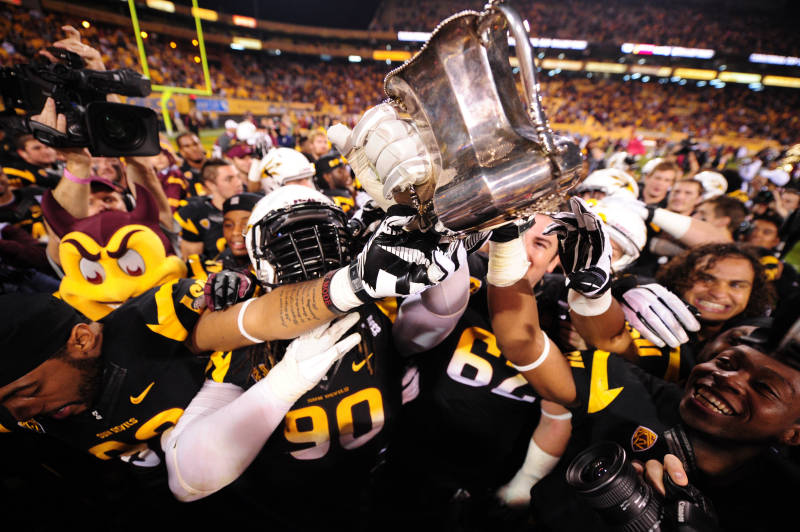
(Photo: ASU Athletics)
The No. 11 Arizona Wildcats playing host to the No. 13 Arizona State Sun Devils represents a matchup that carries a little more weight than the usual Territorial Cup duel.
Not since 1986 has the annual battle for supremacy in The Grand Canyon State featured a battle between ranked teams, and there haven’t been many games between the rival schools that carry as many implications as there are on the line on Friday.
Still, the rivalry that dates back to a game in Nov. 30, 1899 and will have its 88th installment on Friday, has a lengthy history with significant moments. Here are the top five most significant games in Territorial Cup history:
5) Block party – 2010 – Arizona State 30, Arizona 29
For drama alone, the second-to-most-recent trip to Tucson for the Sun Devils deserves inclusion on the list. All in all, it was a game riddled with lackluster offense, as the two teams combined for 18 punts and a whole lot of inability to score. Nevertheless, the Wildcats managed to put together a 10-play drive with under 10 minutes to play and connect on a five-yard touchdown from Nick Foles to David Douglas that appeared to be the game-winner.
Instead ASU’s James Brooks blocked the ensuing extra point and etched his name in Territorial Cup lore by blocking another extra point in double overtime, sealing a victory for the Sun Devils.
4) Missing out on roses – 1985 – Arizona 16, Arizona State 13
A UCLA loss earlier in the day meant the 8-2 Sun Devils were a win or tie away from the first trip to the Rose Bowl in school history. Locked in a 13-13 tie with about three minutes to go, and no overtime rules at the time, ASU passed on consecutive downs instead of continuing to run out the clock. A third-down pass was especially disastrous though, as it resulted in a sack and fumble that gave the Wildcats the ball on ASU’s 20-yard line.
Arizona’s Max Zendejas kicked the game-winning field goal shortly thereafter, sending the disappointed Sun Devils to the Holiday Bowl instead, where the team lost to Nebraska, 18-17.
3) The Catch – 1975 – Arizona State 24, Arizona 21
In an era long before booth reviews and slow-motion replays from multiple angles, there was a catch by ASU’s John Jefferson in a monumental matchup between No. 8 ASU and No. 12 Arizona. The 10-0 Sun Devils fell behind 14-3 early, but an 8-yard touchdown pass from Dennis Sproul to Jefferson just before halftime cut the Wildcats’ lead to four and pushed all the momentum in ASU’s favor.
“The Catch,” which is better seen than described, sparked a comeback that sent the Sun Devils to the Fiesta Bowl as part of an undefeated season that ended with ASU ranked No. 2 in the nation.
2) Undefeated no more – 1986 – Arizona 34, Arizona State 17
While the 1975 Sun Devils finished undefeated and earned a victory in the Fiesta Bowl, no team was better positioned for greatness than ASU’s team in 1986. At No. 4 in the nation and boasting a 9-0-1 record, Arizona State had already clinched its first-ever trip to the Rose Bowl before a matchup against Arizona.
The Wildcats led for the majority of the game, but ASU threatened to cut into a 24-10 lead after driving all the way to Arizona’s 5-yard line. Instead, Jeff Van Raaphorst threw an ill-advised pass across his body that was intercepted by Chuck Cecil and returned 106 yards for a game-sealing touchdown.
1) The Ultimatum Bowl – 1968 – Arizona State 30, Arizona 7
The game itself wasn’t a close or thrilling one, but it was the most influential in the history of college football in Arizona. The 1968 matchup was to decide the WAC champion and the team destined for a trip to the Sun Bowl, which would have been ASU’s first bowl appearance since the 1951 Salad Bowl. Instead Arizona head coach Darrell Mudra issued an ultimatum to the Sun Bowl selection committee that the Wildcats would refuse to play in the game unless an invite was issued before the Territorial Cup game.
Arizona lost by 23 to ASU and lost by 24 to Auburn in the Sun Bowl, while the 8-2 Sun Devils were left without a bowl game to compete in. The ultimatum added to the heated in-state rivalry and contributed to the addition of the Fiesta Bowl, which intended to provide WAC champions an automatic berth. The Fiesta Bowl eventually evolved into a BCS Bowl and is now one of the New Year’s Six decided upon by the College Football Playoff selection committee.


